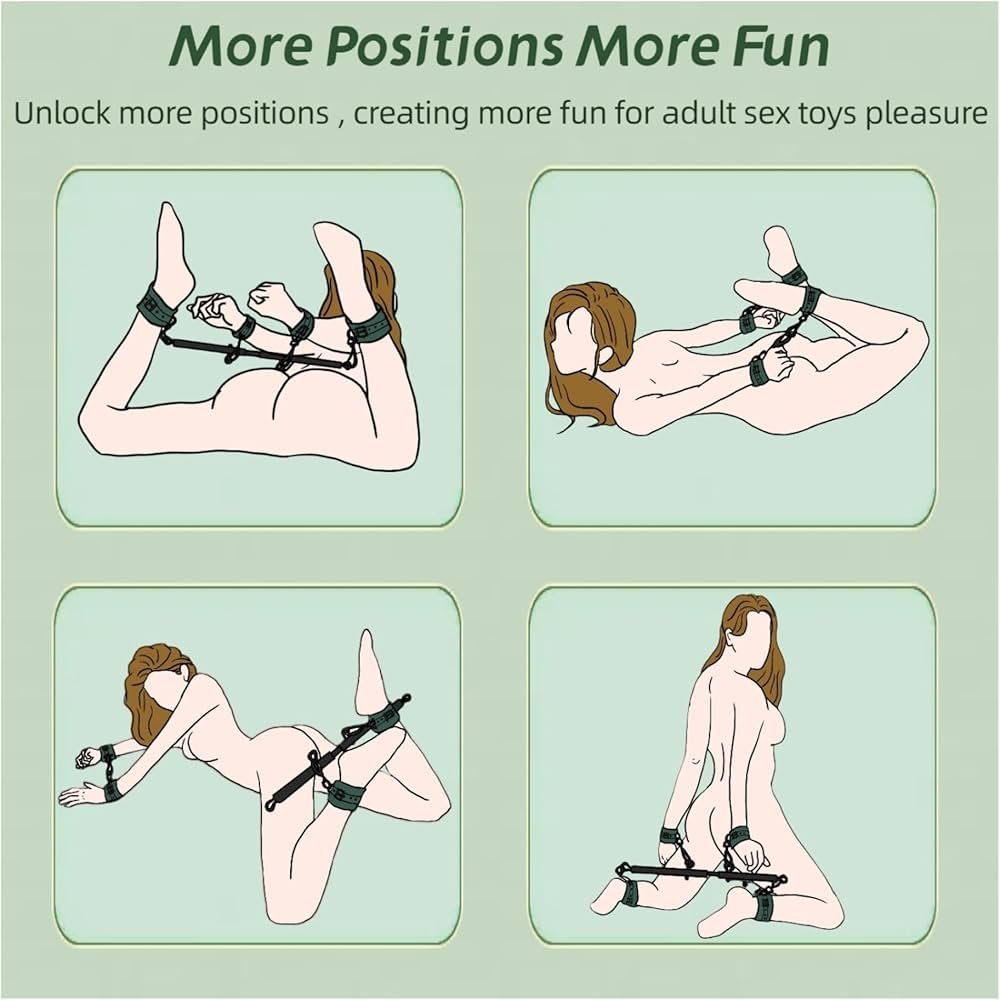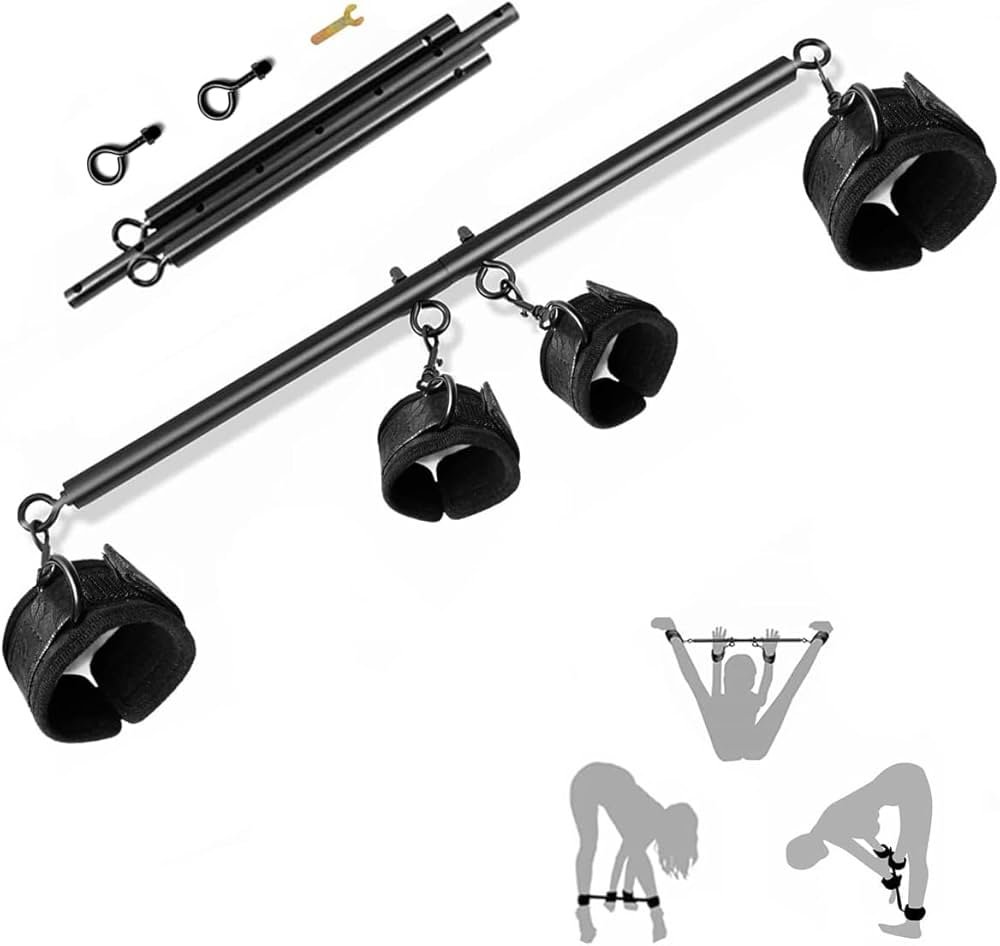Spreader Bar Sex: A Guide For Beginners
If you’re curious about adding something new to your intimate life, the spreader bar might be just the thing you’re looking for. You may have heard the term, but what exactly does it mean? Simply put, a spreader bar is an interesting piece of bondage gear designed to keep your legs or arms apart while adding a level of excitement and fun. Don’t worry—this isn’t as intimidating as it might sound! In fact, many people find it a great way to experiment with new levels of intimacy. Today, let’s dive into the world of spreader bar sex, explore its benefits, and answer some burning questions that may help you decide if it’s right for you and your partner. Ready to learn more about it? Let’s go!
What is a Spreader Bar?
A spreader bar is a versatile piece of bondage equipment, typically consisting of a long bar with cuffs or straps affixed to either end. It is designed to restrict movement, creating a sense of vulnerability or discomfort, but often with an element of comfort. This tool plays a significant role in BDSM or kink play, facilitating control while enabling deep exploration of consensual dynamics.
Construction and Material
Spreader bars are available in various materials such as wood, metal, or plastic, providing different experiences in terms of rigidity and weight. The length of the bar can vary, ranging from compact options to longer versions designed for more intense restraint. The cuffs at the ends, usually made from leather, adjustable straps, or Velcro, are designed to securely hold the wearer’s limbs, often the arms or legs, in place.
Purpose in BDSM and Kink Play
The primary function of a spreader bar is to separate and immobilize parts of the body, typically arms or legs, creating a sensation of helplessness and vulnerability. This separation leaves the restrained individual in a more exposed position, adding intensity to roleplay or power exchange scenes. By limiting movement, it amplifies physical sensations and mental states, such as arousal and anticipation.
Spreader bars can also enhance sexual pleasure during restraint play, by keeping a person in a position where their body is exposed to sensations from other elements of the scene—whether they be touch, toys, or spanking.

Variations in Design and Function
A spreader bar may also feature adjustments that can regulate the distance between the cuffs to adapt to a wide range of comfort levels. Some models may even allow for quick release features in case an individual becomes uncomfortable. While it is most commonly used in leg and arm positioning, some configurations support neck, ankle, or wrist attachment, depending on the style and complexity.
Consent and Communication
As with any BDSM or kink equipment, it is crucial that spreader bars are used with mutual consent and understanding between the involved parties. Communication is key to ensuring the experiences are enjoyable, safe, and positive for everyone involved. Understanding one’s comfort zone, limits, and establishing safe words can create a safe environment for exploring new dimensions of pleasure. In this way, the spreader bar becomes a useful tool in consensual play, promoting power dynamics, submission, or domination while preserving mutual respect and trust.
Exploring Boundaries
A spreader bar encourages partners to explore new dynamics and physical boundaries, allowing participants to step out of their usual comfort zones with confidence. It can be employed both for more intense or gentler scenarios, based entirely on preferences and the mood set by those involved.
A spreader bar’s purpose is not solely about dominance or restraint; it fosters an environment where imagination can take the lead, offering both power and pleasure in ways that are tailored to the limits and desires of those who engage with it. With proper guidance, care, and respect for boundaries, it can enrich the experience of any BDSM scene or role-play scenario.
Why People Use a Spreader Bar in Sex Play
When it comes to incorporating a spreader bar into the bedroom, it’s not just for those who identify with the BDSM or kink communities. While it’s true that the spreader bar is often featured in more intense BDSM scenes, its uses extend far beyond that. People of all preferences and sexualities find enjoyment in exploring the sensations, dynamics, and intimacy that a spreader bar can create. Let’s break down the different reasons why people might incorporate this unique tool into their intimate encounters.
Increases Sensation and Heightens Arousal
One of the most prominent reasons for using a spreader bar during sex play is the amplification of physical sensations. When certain body parts—typically arms or legs—are bound and unable to move freely, the rest of the body becomes more sensitive to touch. The spreader bar forces a person into a position where they cannot move, leaving every touch, kiss, or stroke to feel more pronounced and thrilling.
For example, imagine a simple touch on the skin or the sensation of fingers gliding across the body. When your body is immobilized, these sensations become incredibly heightened, which can result in a higher level of arousal. It’s not just about restraint; it’s about allowing the body to experience pleasure in a more acute, intensified form.
This heightened sensitivity is a fundamental reason why people may use a spreader bar in intimate settings. For some, these amplified sensations can be the difference between a good sexual experience and an incredible one, bringing new dimensions to orgasmic pleasure or deep erotic intimacy.

Power Dynamics and Role-Playing
When engaging in power dynamics, whether through dominance and submission (D/s), the spreader bar can become an incredibly useful tool. By placing one partner in a submissive, immobile position, the dominant partner gains a visual, tangible representation of control. It emphasizes the power exchange that can be a fundamental element of BDSM play.
For those exploring power dynamics, a spreader bar adds an additional layer to the scene. It not only shows who is in control, but also establishes a clear boundary between the dominant and submissive roles. This enhances the psychological aspect of BDSM and role-playing by using physical restraint as a method of exerting power and providing structure to the exchange of control.
Additionally, the spreader bar is especially popular in impact play, such as spanking, paddling, or flogging. The position created by the bar can leave certain body parts exposed, making them more accessible to the dominant partner. This might make activities such as spanking or stimulating the intimate areas of the restrained partner feel more intense and emotionally engaging.
However, power dynamics are highly personal and should always be consensual and pre-negotiated. For people exploring power roles, the spreader bar is merely one tool to help create a fun, safe, and exciting exchange of control within a consenting adult relationship.

Adds Playfulness and New Intimacy
While the spreader bar is often associated with serious BDSM play, it can also be a tool for lighthearted exploration. Not everything needs to revolve around power exchanges or physical control. Sometimes, couples just want to spice things up and experience new types of intimacy—and the spreader bar facilitates this.
The novelty of being in a unique, spread-out position allows couples to discover new forms of connection and closeness that they hadn’t considered before. Some partners simply enjoy the idea of trying different ways to playfully position and challenge each other physically while still maintaining comfort, excitement, and trust.
For example, some couples might use the spreader bar as a fun way to stretch boundaries, testing their comfort zone in a controlled, consensual environment. In this sense, the play might not be focused on dominance or submission, but rather on intimate exploration and the joy of trying something unfamiliar together. It creates openness and connection, inviting people to trust each other as they experience new, tender interactions—sometimes tender and exploratory, other times more playful and flirtatious.
The spreader bar adds a sense of adventure to intimacy. With both partners fully aware that the position could lead to new and exciting sensations, there’s an undeniable sense of curiosity in exploring something different—whether it be through sensory touch, eye contact, or just allowing the act to feel fresh and spontaneous.
Stress Relief and Playful Fun
Finally, a key reason why people incorporate a spreader bar into their sexual practices is the stress-relieving aspects of play. Many people find the act of fully letting go and surrendering control in a safe, consensual space to be deeply relaxing. When you trust your partner and allow them to guide the experience, you might find a significant release from day-to-day pressures or anxieties.
As for others, the mental escapism and playfulness of being restrained or playfully positioned allows them to distance themselves from external stresses and focus entirely on each other. The spreader bar facilitates a form of playful connection, whether used as a tool for sexy fun, improving romantic chemistry, or giving partners the chance to deepen their level of affection and intimacy without the need to overthink every action.

How to Use a Spreader Bar Safely and Comfortably
Incorporating a spreader bar into your intimate play can be a fun and exciting experience, but it’s important to approach it with caution to ensure that everyone feels safe, comfortable, and able to fully enjoy the moment. Here are some detailed guidelines on how to use a spreader bar safely and comfortably, ensuring a positive and fulfilling experience for both you and your partner.
1. Start Slow and Explore Gradually
If you and your partner are new to the spreader bar, it’s crucial not to rush into anything too intense right away. Start with low levels of restraint and position adjustments, taking small steps toward discovering how the tool affects your body and the dynamics of your experience. Whether you’re exploring it in a playful or more intense setting, gradual exploration allows you both to ease into it without overwhelming the body or mind.
Begin by placing one cuff at a time, slowly testing out different levels of tension and positioning. Experiment with how far apart you want the cuffs to go or how long you’d like to remain in a position before switching it up. Starting slow ensures both you and your partner can readjust and explore comfort levels before committing to more extreme positions. A slower pace allows you to build trust, communication, and understanding about each other’s needs.
2. Communicate Openly Before and During Play
Communication is key when engaging in any activity that involves restraint, discomfort, or power dynamics. Before using a spreader bar, have an open conversation with your partner to set clear expectations, boundaries, and limits. Ask each other questions about preferences: Are there certain positions that feel good, or are there specific areas of the body that are sensitive or uncomfortable? Discussing each other’s likes and dislikes helps establish mutual respect and trust, creating an environment where both of you feel comfortable exploring the experience.
While you’re using the spreader bar, don’t assume things are okay just because your partner has agreed to participate. Encourage ongoing, open communication during play, making sure both partners continue to check in. Whether through physical cues (like gentle touches or moving in certain ways) or verbal feedback, communication keeps both of you in tune with the experience, ensuring it remains enjoyable for everyone involved.
3. Ensure Comfortable Restraint with Soft, Adjustable Cuffs
When it comes to the actual cuffs on the spreader bar, comfort should be a priority. The last thing you want during play is discomfort from tightly bound or ill-fitting restraints. Ideally, the cuffs should be soft, adjustable, and made from materials that won’t cause irritation or pinching.
Opt for cuffs made of soft leather, fabric, or faux leather (which tend to be gentle on the skin while still holding the user firmly). Velcro straps can work well for making quick adjustments in tightness to ensure the cuffs aren’t digging into the skin. For a safe and pleasant experience, make sure the cuffs are snug but not overly tight—your hands or legs should not feel numb, and circulation shouldn’t be restricted.
Regularly check in with your partner about how the restraints feel as they’re in use. Ensure they have the ability to freely shift a little if needed. This maintains comfort and prevents any discomfort, bruising, or chafing, allowing for a more relaxed and enjoyable experience.

4. Use Safety Words for Immediate Communication
When engaging in any type of play that involves power dynamics or restraints, it’s vital to have a clear and accessible safety word or system in place. This is especially important if the experience may turn more intense or if either partner becomes overwhelmed. A safety word is a prearranged word or signal that immediately stops all action, signaling that either partner wants to pause, adjust, or end the scene.
You can create a simple safety word system that uses colors (green for go, yellow for slow down, and red to stop), or you might prefer a unique word that can be easily remembered in a moment of excitement. What matters is that both partners are comfortable using the safety word at any time without feeling judged or pressured. This gives a sense of emotional security, knowing you both have a reliable tool to ensure safe play.
In case of emergency situations, it’s also a good idea to have physical signals in mind. If speech or words are difficult to say, tapping the floor, shaking the head, or giving a thumbs-down can quickly indicate that something needs to change, ensuring you don’t have to communicate too complexly in a vulnerable moment.
5. Stay Within Your Comfort Zones
While the spreader bar is an exciting tool that can introduce new sensations, power dynamics, and intimacy, it’s essential that both partners stay within their comfort zones. Always check that your partner is still feeling at ease in their restraints and hasn’t entered a space of discomfort or distress. This can be done by observing non-verbal cues such as body language or facial expressions.
Know when it’s time to adjust, ease back, or introduce a different playstyle or position. If you notice any tension, strain, or discomfort in your partner, immediately adjust the restraint levels. This not only promotes safety but also helps strengthen the bond of trust and respect that is essential for a fun, fulfilling sexual experience.
In the same light, don’t let a new activity like using a spreader bar pressure either partner into pushing through discomfort. Everyone has limits, and it’s perfectly acceptable to stop at any point. Consent is fluid and ongoing, and all actions should be enjoyable, so make sure everything is progressing at a pace that feels good for both individuals.
6. Consider Aftercare for Both Partners
Aftercare is an often-overlooked but crucial element of any session involving restraints, power play, or intense stimulation. Following the use of a spreader bar, take the time to care for each other both physically and emotionally. Gently removing the cuffs and helping your partner re-center, stretch, or relax can go a long way in maintaining trust and support after intense activities.
Engage in kind words, warm touch, and possibly hydration, ensuring both partners feel taken care of and emotionally secure. Physical and emotional aftercare supports intimacy and lets both individuals feel that their experience is acknowledged, respected, and valued—ultimately allowing your connection to be safe, healing, and nurturing after what might have been an intense experience.
In Summary:
Using a spreader bar safely and comfortably requires a thoughtful approach that centers around gradual exploration, clear communication, and emotional and physical support. When done correctly, it enhances physical sensations and adds an exciting dynamic to intimate experiences while prioritizing the health, safety, and well-being of everyone involved. Remember to check in with each other consistently, use tools that maximize comfort, and always respect boundaries to make your spreader bar experience as enjoyable as possible.

Can Spreader Bars Be Used in Other Types of Play?
While spreader bars are most commonly associated with BDSM or kink activities, they are a versatile tool that can be incorporated into various kinds of sexual play and dynamics beyond the intense worlds of restraint and domination. Their capacity to restrict movement and create new sensations makes them a fun and exciting addition to many different types of intimate scenarios. Whether you’re exploring new ways to play or simply looking for something fresh, the spreader bar can bring a sense of novelty and creativity to your interactions. Here are a few fun and non-traditional ways a spreader bar can be used to spice things up:
1. Spreader Bars for Foreplay
While many may associate a spreader bar with bondage play, it can also be a playful addition to the art of foreplay. It can be used gently as part of an interactive tease to change up the pace and mood. Imagine slowly restraining your partner’s legs or arms with the spreader bar while engaging in close physical touch, soft kissing, or sensual oral attention.
This simple yet effective way of using a spreader bar brings a new element of anticipation and restriction that shifts the power dynamics and adds intensity to an otherwise casual or familiar moment. By spreading your partner’s legs, you create a feeling of both vulnerability and heightened sensation while focusing on smaller, intimate actions, such as caressing, massaging, or soft kissing. It’s a fun way to get into a more adventurous headspace without diving straight into something hardcore. This playfulness can awaken a heightened sense of connection and erotic tension, laying the groundwork for even more passionate experiences later on.
2. Enhancing Sensory Play
Sensory play focuses on intensifying sensations through different stimuli, and the spreader bar fits into this area beautifully. Immobilizing a person’s limbs or torso allows them to focus entirely on the sensory experiences provided by the other partner, whether it’s a soft caress, a cool touch, or gentle pressure from a variety of objects. When combined with different techniques—like light strokes, gentle pinches, or a soft brush against the skin—the lack of movement turns everyday sensation into something far more intense.
For example, you might apply ice, hot wax, feathers, or even a simple gentle tickling technique while your partner’s body remains stationary and fully restrained. Each sensation becomes magnified because there is nowhere to run or react except in response to what’s being done. The element of anticipation increases, as your partner’s body remains under restraint, unable to move freely away from stimuli, thus making each touch that much more exciting and sensitive.
Alternatively, some might enjoy incorporating more intense forms of touch, such as spanking or whipping, in a controlled and playful environment with a spreader bar helping restrict their movements during impact play. Sensory play doesn’t always have to be about restraint for submission—it can also be about providing different kinds of touch and sensation in a safe, comfortable space where boundaries are respected.
3. Spreader Bars in Role Play Scenarios
The role-play scenarios that often appear in kink communities don’t necessarily need to involve heavy domination, pain, or control. A spreader bar can serve as a key accessory in lighthearted and imaginative role-playing experiences, allowing participants to create fun, fantasy worlds without necessarily going all-in on hardcore restraint or BDSM elements. Think about it: if you’re indulging in a teacher-student or nurse-patient scene, a spreader bar can enhance the dynamic of “restraint” and contribute to the fantasy.
For example, in a classic nurse-patient role play, you could place a patient in a position where their legs or arms are spread, setting up a playful or mildly teasing “exam” scenario. The restraint from the spreader bar not only helps establish that controlled “constraint” feeling typical of medical fantasy but also creates an interesting sense of heightened attention on the caregiver-patient dynamic, adding an extra element to the fantasy.
Similarly, in teacher-student fantasies, the spreader bar could be used to symbolize control, where the “teacher” positions the student in a particular way to “teach” them something—whether that’s intellectual, physical, or purely playful exploration. Incorporating the spreader bar keeps the scenario grounded in a role where one person has power, but the approach is still lighthearted rather than intense.
This application lets you enjoy power exchange while keeping things fun and a little playful, without entering deep kink territory. The psychological component of the role play can be enhanced by the spreader bar, creating immersion into the fantasy itself.

4. Heightening Sensual Bondage Play
Although used more formally in BDSM or kink contexts, a spreader bar can also serve a purpose in sensual bondage play, where restraint is only part of the experience, and the focus is on fostering connection, vulnerability, and tender intimacy. The spreader bar helps you position your partner in such a way that you can enjoy a lot of physical closeness, whether that means cuddling, kissing, or deep mutual eye contact, while still maintaining a sense of physical connection and holding them in place.
For example, incorporating it in a calm and emotionally connective scene allows both partners to let go of control for a moment and allow their body language to do the talking. By restraining the body in certain ways, such as spreading the legs apart, a partner might feel exposed and vulnerable, which, in turn, allows the other partner to express care, tenderness, and emotional availability. Gentle touch, whispering sweet nothings, or kissing all become amplified when paired with this feeling of restraint—it’s an intimacy that conveys both vulnerability and trust at the same time.
In this case, the spreader bar encourages surrender—a letting go of control, of responsibility. By simply being present with one another, you deepen your connection.
5. Exploring Tease and Denial
Another common way that spreader bars are used outside of traditional BDSM contexts is for tease and denial. In this type of play, the person using the spreader bar would secure their partner in place but may refrain from allowing them any immediate relief or pleasure, thus building tension and a playful challenge. Since the partner is restrained and unable to control their movements, they are often left at the mercy of their partner’s teasing—whether through light touches, near misses, or verbal stimulation—further adding to the anticipation.
The power dynamic in this setup comes from the element of delay and frustration, not necessarily pain or punishment. The idea is to heighten excitement, build suspense, and let the sense of longing make each touch, word, or kiss more impactful.
Spreader bars are not confined to extreme power play, and their utility in a variety of intimate and sensual contexts speaks to their versatility. From adding light-hearted teasing to enhancing sensory experiences, role-playing scenarios, and exploring sensory deprivation or tease and denial play, a spreader bar can serve as a helpful and creative tool to broaden the spectrum of ways in which you explore connection and intimacy in a relationship. When used safely and respectfully, it has the potential to increase physical pleasure, add depth to emotional experiences, and make your sexual play more exciting, varied, and fun—regardless of the dynamics at play!
Final Thoughts: Exploring the Fun, Playful World of Spreader Bars in Intimate Play
In conclusion, whether you’re a BDSM aficionado or someone simply curious about adding something new to the bedroom, a spreader bar can open the door to exciting, playful, and intimate experiences. Its versatility, whether you’re looking to enhance your sensory play, roleplay fantasies, or just bring something fresh to foreplay, makes it a tool worth considering.
As with any form of experimentation, communication and mutual trust are the essential components of a safe, enjoyable experience. The key is to approach it with an open mind, respecting each other’s boundaries, and focusing on fun over perfection. Ultimately, this exploration is about strengthening your connection with your partner while having a little adventurous fun along the way.
Now that you have an idea of how to use a spreader bar, have you incorporated one into your intimate life? We’d love to hear your thoughts, stories, and tips! Feel free to drop us a comment below and share how it went!
Are you curious to know more about BDSM? I wrote a blogpost with BDSM Ideas which hopefully can give you inspiration.








